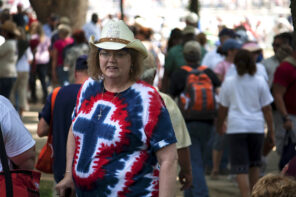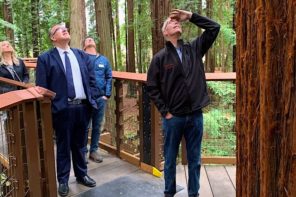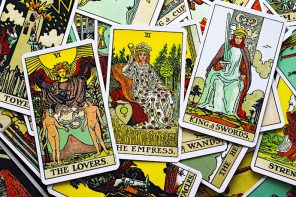You can call them “unaffiliated,” as in a recent Pew poll, or “nones”—or even just “not very religious.” A brand new poll by the Public Religion Research Institute divides this group further (and somewhat counterintuitively) into “unattached,” “atheists/agnostics,” and “seculars.” But whatever you call them, this ever-growing cohort of unchurched Americans makes up, at 23 percent, the single largest segment of Barack Obama’s “religious coalition” (compared to the 37 percent of white evangelicals who support Mitt Romney).
While we have yet to see a “Seculars for Obama” bumper sticker, the unaffliated are clearly having a moment. Media analysis, however, has not gone very deep—there is a story here that goes beyond names and numbers.
Recent sociological work from Courtney Bender, Christian Smith, and others does help us understand who the current crop of unaffiliated are and what they do and believe. Yet we have precious little historical understanding of this critical and growing demographic. What are their roots? What religious, cultural, economic, demographic, and political processes shaped their sensibilities, habits, and makeup?
In order to understand these still-believing “nones,” we need to understand that much of the religious dynamism in the United States happens outside the church walls, and has for some time now. The “rise of the nones” is but the latest phase in the long transformation of religion into what we now commonly call “spirituality.” In my class on “Spirituality in America” at the University of Virginia, we use Leigh Schmidt’s pathbreaking Restless Souls to trace this phenomenon over two centuries, from Ralph Waldo Emerson’s break with New England Unitarianism in the 1830s to the multibillion dollar spirituality industry of today.
Spirituality can mean many things, of course, and the language of spirituality is used by traditional religious adherents as well as the religiously unaffiliated. But only the “nones” have made it into a cliché: “spiritual but not religious.”
The history of American spirituality reveals that our commonplace understanding of spirituality—as the individual, experiential dimension of human encounter with the sacred—arose from the clash of American Protestantism with the forces of modern life in the nineteenth century. While religious conservatives fought to stem the tide, giving rise to fundamentalism, religious liberals adapted their faith to modernity, often by discarding orthodoxies in favor of Darwinism, psychology, and comparative religions.
The majority of today’s religious “nones”—those who claim no religion but still embrace spirituality—are engaged in the same task of renovating their faith for a new historical moment. And typically, they draw from this same liberal religious toolkit. Today’s unaffiliated, like the liberals of previous generations, typically shun dogma and creed in favor of a faith that is practical, psychologically attuned, ecumenical—even cosmopolitan—and ethically oriented.
This liberal spirituality, as it has evolved over time, has been deeply entwined with media-oriented consumerism. Of course Americans of all religious varieties have been deeply influenced by consumerism, but media and markets have particularly shaped the religious lives of those without formal institutional or community ties. The religiously unaffiliated might not attend services, but they “do” their religion in many other ways: they watch religion on TV and listen to it on the radio; find inspiration on the web; attend retreats, seminars, workshops, and classes; buy candles and statues, bumper stickers and yoga pants; take spiritually motivated trips; and, perhaps most significantly, buy and read books.
Since the 1920s, when the major New York trade presses first started offering nonsectarian religious books in significant numbers, books have been the most important conduit for spreading the “spiritual but not religious” gospel.
This dependency on the consumer marketplace, and especially books, has had significant consequences for the religious lives of all Americans, especially the unaffiliated. First, it has enhanced the tendencies within American religion toward a therapeutic understanding of the spiritual life. The profit-oriented commercial presses that came to dominate religious publishing naturally pursued the largest market possible for their goods, and seized on the non-creedal, nonsectarian, and psychologically modern forms of faith advanced by religious liberals as a common American religious vernacular. These trends have only accelerated from the 1920s to the present, such that now the line between religion and self-help disappears in the spirituality section of Barnes & Noble.
Second, spiritual consumerism has fostered a robust cosmopolitanism. Books allow readers entry into previously unimaginable religious worlds. Since trade presses entered the religion game with vigor, the lines of denomination and tradition have mattered less and less. The political and moral imperatives of World War II provided the greatest stimulus to such interfaith reading, and before long even the Protestant-Catholic-Jew formulation of the era could not contain American readers. What matters to the unaffiliated is not imprimatur but inspiration.
The Notre Dame sociologist Christian Smith has observed, “Liberal Protestantism’s organizational decline has been accompanied by and is in part arguably the consequence of the fact that liberal Protestantism has won a decisive, larger cultural victory.” The “cultural victory” Smith and others write about happened not because more Americans joined liberal churches, in other words, but because liberal religious values and sensibilities became more and more culturally normative. And no single cultural force has been more significant to this profound religious shift than the unabashed consumerism of the religious book business in the twentieth century.
Even as religious affiliations decline, religious books sales continue to rise, as they have steadily for more than a half century. In this ultimate spiritual marketplace, American religion displays its full shape-shifting vitality.




